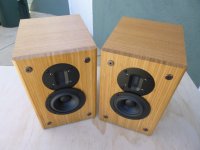One solution is to veneer before cutting holes... but that seems like the wrong order.
I do this. I don't think it's the wrong order 😀
I've accomplished the cut on a few speakers using a Whiteside router bit.
Thanks for the tip on the Whiteside bit. That one looks real promising.
I know that in a factory environment the veneer is applied to the panels early in the process... that makes sense. But as a craftsman, I would prefer to apply the veneer to the finished box so as to minimize the damage to the veneer surface. The surface can be damaged by clamping pressure, tool dings, glue contamination, and countless other ways. Of course it is possible to do the veneer on the baffle early, and perhaps this is the best way. You all have my admiration if you are able to do this.
A craftsman is able to avoid getting "chicken grease" on his work hifijim. You have to think a project through, start to finish. Otherwise you work yourself into a corner.
Given flat panels, I sure as heck (and have historically) veneered before glue-up, as that meant I could do the process with flat panels, where I have the best chance to get the veneering process right.
Given the shallow nature of a tweeter or woofer frame, downcut spiral to cut the flange recess mitigates the chances of veneer tear out. Then switch to a upcut spiral to cut the speaker hole (assuming a circle jig). Speaker cutouts are the penultimate operation before glue up, so not a lot of chances to ding/damage parts at that point (be careful of course!)
Pattern following bit for cleanup is another clever idea mentioned above.
Hope your baffle is pretty narrow -- bonding thick solid wood to thick engineered wood has the potential to put a lot of shear stress on the glue bond due to the differential growth/shrinkage with humidity.
Given the shallow nature of a tweeter or woofer frame, downcut spiral to cut the flange recess mitigates the chances of veneer tear out. Then switch to a upcut spiral to cut the speaker hole (assuming a circle jig). Speaker cutouts are the penultimate operation before glue up, so not a lot of chances to ding/damage parts at that point (be careful of course!)
Pattern following bit for cleanup is another clever idea mentioned above.
Hope your baffle is pretty narrow -- bonding thick solid wood to thick engineered wood has the potential to put a lot of shear stress on the glue bond due to the differential growth/shrinkage with humidity.
- Home
- Loudspeakers
- Multi-Way
- veneer on recessed tweeter

